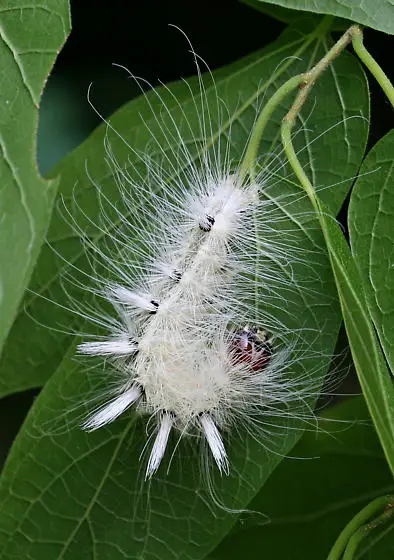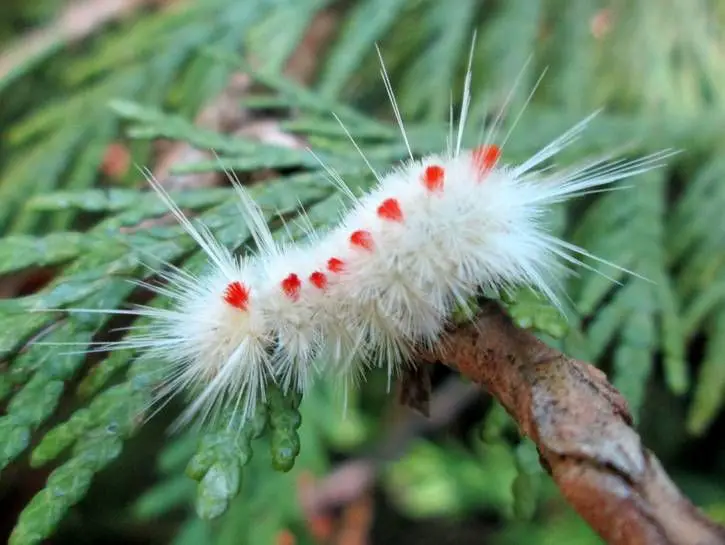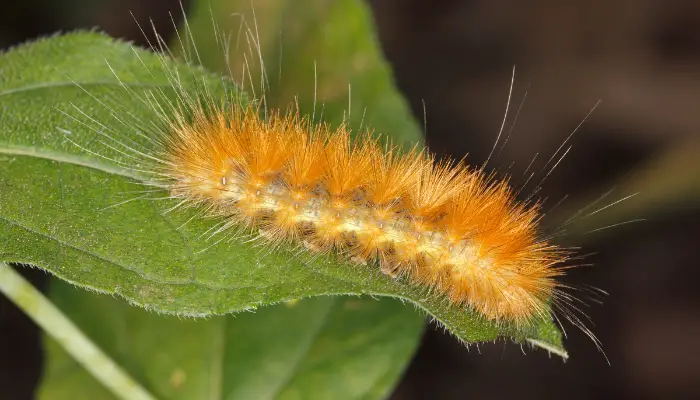Exploring the Enigmatic White Fuzzy Caterpillar with a Red Head
Caterpillars, those delightful larval forms of moths and butterflies, never cease to amaze us with their diversity and peculiarities. Among this kaleidoscope of insect life, the white fuzzy caterpillar with a red head stands out as a captivating and mysterious creature. In this blog post, we’ll delve into the intriguing world of these caterpillars, uncover their secrets, and appreciate their role in our ecosystems.

Meet the Sycamore Tussock Moth Caterpillar
The white caterpillar with a red head you’re curious about is likely the sycamore tussock moth caterpillar. Let’s get to know this remarkable species:
- Appearance: The sycamore tussock moth caterpillar boasts a creamy-white body adorned with dense tufts of hairs. Its black head gleams with a touch of red, creating a striking contrast. These caterpillars are soft and fuzzy, making them easy to spot against green foliage.
- Habitat: You’ll find these caterpillars in deciduous forests, woodlands, and areas rich in trees. They thrive where their preferred host plants, such as sycamore trees, are abundant.
- Life Cycle: Like all caterpillars, the sycamore tussock moth caterpillar undergoes metamorphosis. After feeding voraciously on leaves, it eventually transforms into a pupa and emerges as a beautiful moth.
Defense Mechanisms and Adaptations
- Venomous Spines: While some white caterpillars are harmless, others wield potent defenses. The sycamore tussock moth caterpillar falls into the latter category. Its tufts of white and black hairs contain venom. When touched, these hairs can pierce the skin, causing a sensation akin to a bee’s sting. It’s a reminder that appearances can be deceiving!
- Allergic Reactions: Although not considered highly venomous, the sycamore tussock moth caterpillar’s hairs can trigger allergic reactions in sensitive individuals. Handling them without caution may lead to skin irritation.
Ecological Importance
- Leaf Munchers: Caterpillars play a crucial role in ecosystems by consuming plant material. They’re nature’s recyclers, breaking down leaves and contributing to nutrient cycling.
- Food for Predators: Birds, spiders, and other creatures feast on caterpillars. Their abundance ensures a steady food supply for these hungry predators.
Caterpillar Facts?
Caterpillars are fascinating creatures with a wealth of intriguing facts. Let’s dive deeper into their world:
- One Job: To Eat
- During the larval stage, a caterpillar’s primary mission is to consume enough food to sustain itself through metamorphosis. Without proper nutrition, it may lack the energy needed to complete its transformation into an adult. Some caterpillars can eat up to 27,000 times their body weight during their lifetime.
- Exponential Growth
- Caterpillars increase their body mass dramatically. Within just a few weeks, they grow exponentially. Their cuticle (skin) is pliable, but as they gain size and mass, they molt multiple times. Most caterpillars go through 5 to 6 instars (stages between molts) before pupating.
- First Meal: Eggshell
- When a caterpillar hatches from its egg, its first meal is usually the remainder of the eggshell. The outer layer of the egg, called the chorion, is rich in protein and provides the new larva with a nutritious start.
- Muscle-Bound Insects
- Caterpillars are surprisingly muscular. They have as many as 4,000 muscles in their bodies! Even their head capsule alone consists of 248 individual muscles. About 70 muscles control each body segment, and remarkably, each muscle is innervated by one or two neurons.
- 12 Eyes
- On each side of a caterpillar’s head, there are 6 tiny eyelets called stemmata, arranged in a semi-circle. Although they have 12 eyes, their eyesight isn’t excellent. The stemmata help them differentiate between light and dark, and their head movements assist in judging depth and distance as they navigate.
- Silk Production
- Using modified salivary glands along the sides of their mouths, caterpillars produce silk as needed. Some, like gypsy moths, disperse by “ballooning” from treetops on silken threads. Others, such as eastern tent caterpillars or webworms, construct silk tents for communal living. Bagworms use silk to join dead foliage together into a shelter.
Remember, these seemingly humble creatures play vital roles in our ecosystems, from nutrient cycling to providing food for predators. Next time you encounter a caterpillar, observe it with curiosity and appreciate its hidden wonders! 🐛🌿
Conclusion
Next time you encounter a white fuzzy caterpillar with a red head, take a moment to appreciate its intricate design and the hidden drama of its life cycle. These seemingly humble creatures contribute to the rich tapestry of our natural world, reminding us that even the smallest beings have a story to tell.
Remember, when exploring the outdoors, observe caterpillars with curiosity but handle them with care. Their beauty and mystery deserve our respect.
20 Frequently Asked Questions Related to White Fuzzy Caterpillar With a Red Head
- What is the white fuzzy caterpillar with a red head called?
- The white caterpillar you’re curious about is likely the sycamore tussock moth caterpillar. These caterpillars are commonly found in deciduous forests, woodlands, and areas with abundant trees.
- Are white fuzzy caterpillars venomous?
- Some species of white caterpillars do have venomous spines. For instance, the flannel moth caterpillar is known for its hollow hairs connected to poison sacs. When these sharp stinging hairs pierce the skin, they release toxins that feel like a bee’s sting.
- What are the defense mechanisms of white caterpillars?
- White caterpillars employ various defense mechanisms. Some have long venomous spines, while others contain bitter-tasting substances to deter predators. The sycamore tussock moth caterpillar falls into the former category.
- Where can I find white fuzzy caterpillars?
- Look for them in deciduous forests, woodlands, and areas rich in trees. They thrive where their preferred host plants, such as sycamore trees, are abundant.
- What role do white caterpillars play in ecosystems?
- Caterpillars are essential for ecosystems. They break down leaves, contributing to nutrient cycling, and serve as food for birds, spiders, and other creatures.
- How can I differentiate between harmless and venomous white caterpillars?
- Observe their appearance. While some white caterpillars are smooth-bodied, others are fuzzy. Be cautious with the fuzzy ones, as they might have venomous spines.
- What should I do if I encounter a white caterpillar with a red head?
- Appreciate its intricate design and role in nature. Handle it with care, especially if it’s fuzzy, to avoid any allergic reactions or skin irritation.
- Do white caterpillars change color during their life cycle?
- Yes, some caterpillars start white and become yellow or brown as they develop. Others may be white and furry in their last instars.
- Can I find white caterpillars on specific trees?
- Yes, look for them on trees like hickory or where their host plants are prevalent.
- What’s the connection between white caterpillars and moths?
- All white caterpillars belong to the insect order Lepidoptera, which includes both moths and butterflies.
- Are white caterpillars beneficial for gardens?
- Yes, they contribute to nutrient recycling by consuming plant material.
- How can I identify a specific white caterpillar species?
- Look for black spots, yellowish-white or white setae (fine hairs), and protrusions on its body. These features help distinguish different species.
- What’s the significance of the sycamore tussock moth caterpillar?
- It’s a fascinating species found in deciduous forests, woodlands, and areas rich in trees. Its striking appearance makes it stand out.
- Can white caterpillars cause skin irritation?
- Yes, some species, like the flannel moth caterpillar, can cause skin irritation due to their venom-filled spines.
- Why are white caterpillars important for biodiversity?
- They serve as a crucial food source for various predators, ensuring a balanced ecosystem.
- What’s the life cycle of a white caterpillar?
- Like all caterpillars, they undergo metamorphosis, eventually transforming into moths or butterflies.
- Are white caterpillars nocturnal or diurnal?
- Their activity patterns vary, but many are nocturnal, feeding during the night and resting during the day.
- Can I keep white caterpillars as pets?
- While it’s possible, it’s essential to provide the right environment and food for their specific species.
- What’s the average size of a white fuzzy caterpillar?
- The sycamore tussock moth caterpillar can grow up to 2.5 inches long.
- How can I appreciate white caterpillars in my garden?
- Observe them with curiosity, learn about their unique traits, and respect their role in nature
References:








